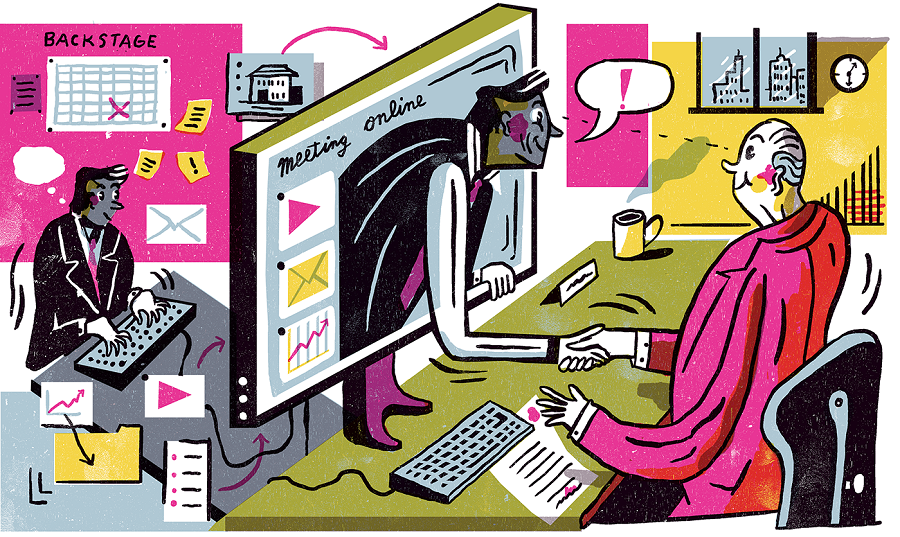Combine your tech and client skills to help ensure more success no matter how you meet
In ways large and small, how we interact with each other has changed over the past decade. In-person meetings are becoming increasingly fewer with the development and use of sophisticated video conferencing programs on computers, tablets, and phones. This has led to the concept of “Virtual Selling,” where the financial professional interacts with prospects and clients using email, phone, and video more than in person.
Bill Sweeney, AVP and program director with Global Atlantic Consulting, points to Mastering Virtual Selling: Orchestrating Sales Success, a recent book by sales consultants Yuchun Lee, Tony Jeary, and Mark Magnacca as a guide to navigating this new approach to client communications.
The authors divide virtual selling into two categories: backstage and frontstage. Backstage is simply defined as emailing a client materials and information in support of a meeting. Frontstage is live and real–time communication like an in-person meeting "Mastering both approaches is critical to successful virtual selling and can lead to a better overall client experience..." or a phone or video meeting.
“It’s helpful to think of it like Disney World,” says Sweeney. “On the frontstage are the big presentations and interactions with guests, and in the backstage are all the pieces that support the frontstage to make the Disney experience appear seamless.”
Mastering both approaches is critical to successful virtual selling and can lead to a better overall client experience and greater sales. This guide shares highlights from the book and Sweeney’s experience:
Preparing your backstage
The book shows how your backstage communications helps to keep you at the top of your clients’ minds when you’re not talking to them live. For a meeting with a military veteran, for example, you may want to share an outline of what your meeting will cover as well as supporting materials like articles, white papers, and charts relating to that person’s needs.
The basic rule is that any content that doesn’t need to be shared in your live meeting should be shared backstage. Doing this before (and after) your virtual meeting helps keep the frontstage “clear.” You’re not distracted by taking time during the meeting to email, and your client has time to download and look at the material on their own time.
Let’s say you have a video meeting scheduled for tomorrow with a client to go over their asset allocation. The day before, you email a meeting agenda, list of topics you’ll be covering, and a relevant article you found on one of the topics. After the meeting you email a summation and action plan, as well as a video related to a subject you covered. The effect is to give you a “virtual presence” in the client’s space outside of the meeting, helping them remember you and the information you shared.
In the case of pre-meeting material, sending an agenda is also helpful to build interactions with the client or prospect. “You want to tell them, ‘This is your meeting, is there anything you want to change or add?’ You’ll leave with a better understanding of these three things,” says Sweeney.
Setting the frontstage
One difference between virtual and in-person meetings is their length. When meeting in person there’s usually some time for small talk and catching up before getting into the core of the subject, and even then, there are asides and pauses. You may find your typical in-person meeting takes about an hour.
Expectations around a virtual meeting can vary. There’s some small talk, but clients generally aren’t looking for an hours-long presentation. When practicing your meeting, try to make it fit within a half-hour window to keep it on point. Shorter meetings show you respect your clients’ time and keep you from being tied to your chair in front of a camera all day.
"...it’s the person-to-person connection that’s the best part of our industry.”
“It also probably goes without saying that you should brush up on your active listening skills,” says Sweeney. “Clients want to hear what you have to say, since you’re sharing your expertise. But they shouldn’t feel like they didn’t get a chance to ask a question or make a comment, which is why you should build in moments where you check in with them.”
Becoming adept at using the share files feature of your video platform is helpful. This allows you to share a quickly digestible outline or chart to make a point during your presentation.
There may be times when you’ll host a webinar, inviting a small group of customers and prospects to participate in a group meeting centered around a topic that concerns them. For instance, tips for education professionals as they near retirement. Or maybe the group is made up of members of a family trust to discuss upcoming investment strategies.
Again, the strategy is the same: Start with backstage sharing of agendas and information, conduct the meeting, then follow up with summaries and ideas from the meeting.
Most of all, personalize the meeting even if it’s the fifth video meeting of the day you’ve done on the same subject. “Everyone wants a personalized touch, and as you would with an in-person meeting, ask about their family and work,” says Sweeney. “With video you have other insights. Maybe the client has a guitar in the corner of the room or you see an interesting picture behind them. Create a dialogue, share from your own experience; ultimately, it’s the person-to-person connection that’s the best part of our industry.”
Ready for your closeup
Presenting yourself at an in-person meeting vs. a video conference truly takes a different approach. Here are five tips to look your best:
- When you’re meeting with someone in person, you’re “experiencing” them in 3D. Over video, subtle movements aren’t as obvious. The slight smile you have while the client is talking may not be perceived, or worse, may be seen as a smirk. Practice more exaggerated body language to communicate your points, and always have a good smile during the meeting. When we’re in front of a screen our faces are often expressionless, which you don’t want when a client is giving you information about themselves.
- Experiment with the settings in the video platform to blur your background if it doesn’t look professional. Some also have a “Touch Up My Appearance” feature that can improve your look. Solid colors tend to look best on camera as opposed to strips or designs.
- Having a steady light aimed in front of you creates a better image than lighting from the side or behind you. This means closing the blinds or curtains if you’re sitting in front of a window if you don’t want to appear as a silhouette. Adjust the camera angle so that it’s directly in front of you or just slightly above your forehead. Don’t let the camera point at you from below.
- We all tend to look at the person we’re talking to when video conferencing. The only issue is that the camera is just above your screen so you’re not looking at the client in the eye as you would in person. Consider adding a teleprompter app that lets you load talking points or a script higher on the screen so you’re maintaining eye contact.
- All video platforms can be affected by bugs or buttons that don't work. Most of these occur because of problems on the user’s end. Are you sure your computer or device is updated and has the memory or processing power to handle video? A good practice is to restart your device before meetings to clear the RAM and prevent electronic mishaps. Also, don’t forget to clean the camera lens periodically.
Share
Related resources
More on Practice Management
Your Thriving
Practice
A destination to empower financial professionals to build, manage, and grow their practice
Get started with Global Atlantic
Take the next step with a company that can help elevate your business.
Need help?
Find all the contact information to submit and service your business.











